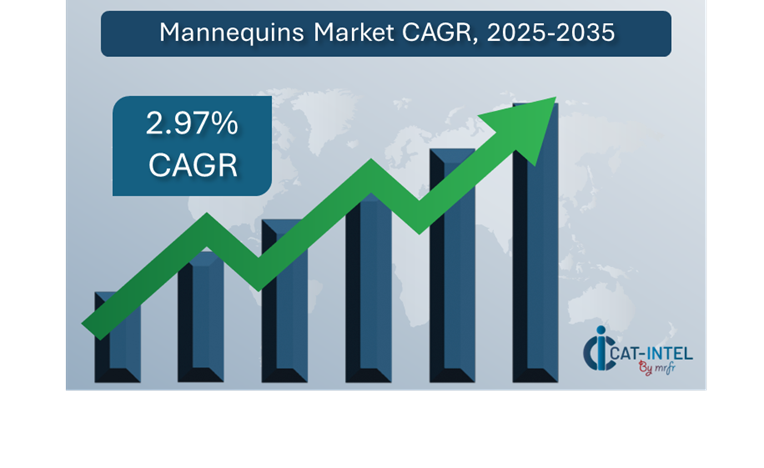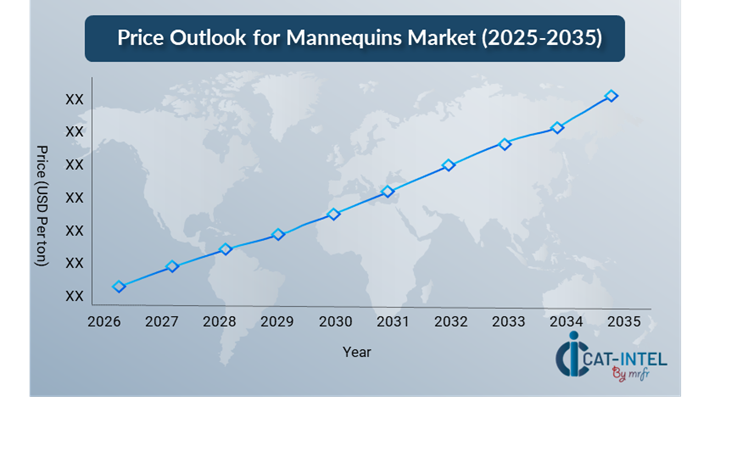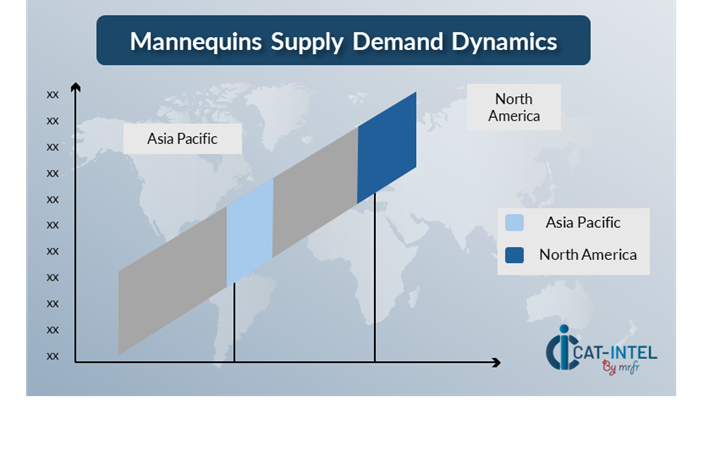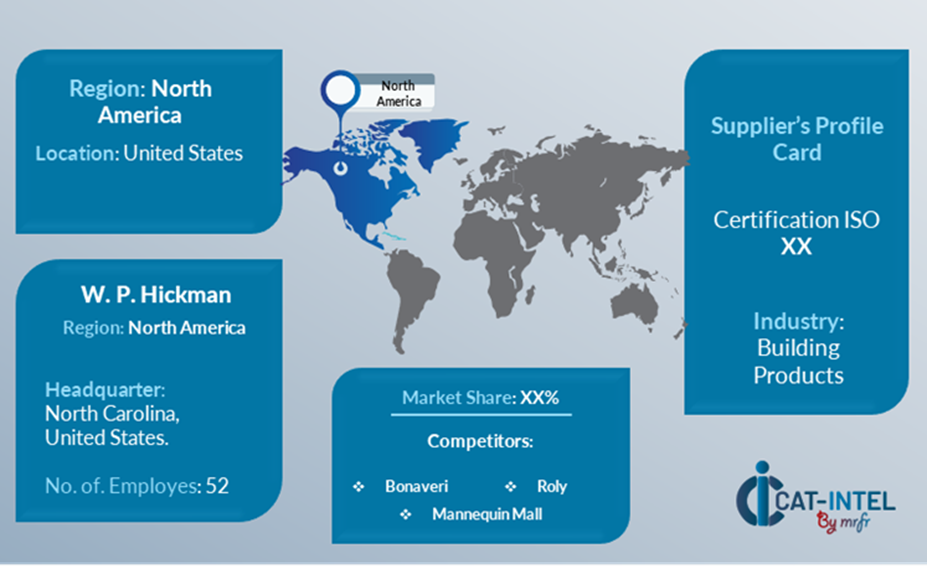Summary Overview
Mannequins Market Overview:
The global mannequin market is steadily expanding, driven by demand from industries like as retail, fashion, and visual marketing. This market contains a variety of mannequins, including full-body, torso, and headless models, to meet a wide range of company demands. Our paper provides a detailed examination of procurement trends, emphasizing cost-cutting methods and the growing dependence on new solutions to improve operational efficiency.
Key future challenges in the mannequin industry include cost management, scalability, product longevity, and integrating mannequins into current retail spaces. Advanced technology and intelligent sourcing are critical for maximizing mannequin acquisition and retaining a competitive advantage. As global demand grows, businesses are using market knowledge to optimize display strategy and reduce operational risks.
Market Size: The global Mannequins market is projected to reach USD 7.32 billion by 2034, growing at a CAGR of approximately 2.97% from 2025 to 2035.
Growth Rate: 2.97%

-
Manufacturing and Supply Chain Optimization: There is a growing demand for real-time data and process integration to increase operational efficiency in the retail and fashion industries.
-
Retail and E-Commerce Growth: Mannequins are becoming more popular in physical and online businesses to improve product display, optimize inventory presentation, and increase consumer interaction.
-
Technological Transformation: Advancements in AI and 3D modelling make mannequin customisation easier, allowing firms to build more realistic and compelling presentations.
-
Innovations: Modular mannequin designs enable organizations to pick and integrate certain models based on their requirements, lowering costs and complexity.
-
Investment Initiatives: Businesses are investing in innovative, lightweight mannequins and materials that lower shipping costs, increase durability, and boost visual appeal.
-
Regional Insights: North America and Asia Pacific are dominating the market due to strong retail and fashion industries, along with an increasing focus on sustainable and customizable mannequins.
Key Trends and Sustainability Outlook:
-
Sustainability Focus: There is a growing demand for mannequins manufactured from sustainable materials and environmentally responsible manufacturing practices.
-
Customization Trends: There is a growing need for mannequins built expressly for various industries such as fashion, healthcare, and retail, enabling for more tailored consumer experiences.
-
Data-Driven Insights: Retailers are employing data-driven insights to improve mannequin display methods, resulting in better alignment with consumer preferences and trends.
-
Scalability Requirements: Mannequin solutions must be readily scaled to meet rising or variable retail demands, such as shop expansions or seasonal promotions.
-
Advanced Feature: Mannequins are combined with smart technologies such as IoT, AR, and interactive displays to provide engaging shopping experiences.
Growth Drivers:
-
Digital Transformation: The use of digital technology in retail and visual merchandising is boosting demand for mannequins that improve both physical and virtual shop displays.
-
Process Automation: Retailers are increasingly using automated inventory and display systems that use mannequins to improve shop layouts and merchandising.
-
Scalability Requirements: Businesses demand scalable mannequin systems that can be quickly tailored to varied shop sizes, seasonal changes, and product lines.
-
Globalization: There is a demand for mannequins that meet global retail standards while also accommodating varied cultural and regional preferences in shop design.
-
Regulatory Compliance: Ensuring that mannequins comply with safety, environmental, and industry-specific laws, such as non-toxic materials and sustainable manufacturing techniques.
Overview of Market Intelligence Services for the Mannequins Market:
Recent investigations have identified important problems like as cost control and the requirement for personalization in mannequin design and manufacturing. Market intelligence studies give useful insights into procurement prospects, assisting firms in identifying cost-cutting strategies, optimizing supplier management, and improving product sourcing. These insights help firms stay competitive by guaranteeing high-quality standards and efficient cost control in mannequin procurement.
Procurement Intelligence for Mannequins: Category Management and Strategic Sourcing
To stay competitive in the mannequin market, organizations are fine-tuning procurement methods through supplier performance tracking and cost research. Effective category management and smart procurement are critical for reducing costs and maintaining a steady supply of high-quality mannequins. Businesses may use market intelligence to negotiate better terms, pick the best models, and improve their entire product presentation techniques.

Pricing Outlook for Mannequins: Spend Analysis
Mannequin prices are projected to remain somewhat volatile, affected by several significant factors. These include advances in materials and manufacturing technologies, rising desire for customisable and sustainable designs, and regional cost disparities. The growing use of smart mannequins, integration with digital technology, and increased attention on eco-friendly materials are also contributing to upward pressure on pricing.
Graph shows general upward trend pricing for Mannequins and growing demand. However, there may be fluctuations influenced by economic conditions, technological advancements, and competitive dynamic.

Efforts to optimize procurement procedures, enhance vendor management, and implement modular mannequin solutions are critical for cost control. Leveraging digital technologies for market monitoring, analytics-based pricing forecasting, and smart contract management can help to increase cost efficiency.
Partnering with reputable mannequin providers, negotiating long-term contracts, and investigating bulk-purchasing alternatives or subscription-based models for display equipment are all effective approaches to reduce mannequin-related costs. Regardless of the hurdles, concentrating on scalability, assuring high-quality product displays, and utilizing sustainable materials will be critical to preserving cost-effectiveness while improving the visual merchandising experience.
Cost Breakdown for Mannequins: Total Cost of Ownership (TCO) and Cost-Saving Opportunities
-
Initial Purchase: (40%)
-
Description: This covers the price of purchasing the actual mannequin, which varies according on design, material, and personalization choices. The cost of mannequins constructed from premium materials is usually greater.
-
Trend: Modular mannequins that are adaptable to various display requirements are becoming more and more popular among retailers. Additionally, 3D-printed mannequins are becoming more popular as an affordable customizing option.
- Shipping and Handling: (XX%)
- Maintenance and Replacement: (XX%)
- Customization and Storage: (XX%)
Cost-Saving Opportunities: Negotiation Levers and Purchasing Negotiation Strategies
In the mannequin business, streamlining procurement procedures and using smart bargaining strategies may lead to considerable cost reductions and increased operating efficiency. Long-term partnerships with mannequin suppliers, particularly those who provide personalized and sustainable solutions, can result in more beneficial price structures and terms, such as volume discounts and bundled service packages. Bulk-purchasing options or multi-year contracts allow you to get reduced rates while minimizing cost variations over time.

Collaborating with suppliers who promote innovation and customisation provides additional benefits, such as access to advanced design alternatives, eco-friendly materials, and adaptable display solutions, resulting in lower long-term operational expenses. Implementing digital procurement technologies like supplier management systems and use data improves transparency, reduces overordering, and maximizes mannequin utilization. Diversifying vendor alternatives and implementing a multi-supplier approach can help to minimize reliance on a single source, eliminate risks like product supply concerns, and increase negotiation leverage for better deals.
Supply and Demand Overview for Mannequins: Demand-Supply Dynamics and Buyer Intelligence for Effective Supplier Relationship Management (SRM)
The mannequin industry is steadily expanding, fuelled by rising demand from industries like as retail, fashion, and visual merchandising. Advancements in materials and manufacturing methods, customer customized requirements, and global economic situations all have an impact on supply and demand.
Demand Factors:
-
Retail and Visual Merchandising Trends: The growing requirement for efficient shop displays and improved consumer experiences is boosting demand for mannequins in all retail industries.
-
Sustainability and Customization: The trend for eco-friendly, customisable mannequins is driving demand for sustainable and diversified display solutions.
-
Industry-special Needs: Mannequins in fashion and healthcare must fulfill special design and functional criteria, such as realistic body forms or ergonomic characteristics for medical environments.
-
Technological Integration: Growing need for mannequins that work with digital displays, illumination, and even augmented reality (AR) systems is increasing the demand for innovative display solutions.
Supply Factors:
-
Material and Design Innovations: Advances in lightweight, durable materials and adaptable designs are boosting mannequin offers and increasing supplier competitiveness.
-
Vendor Ecosystem: With an increasing number of mannequin suppliers, including both large-scale manufacturers and boutique vendors, stores have a variety of possibilities.
-
Global Economic Factors: Raw material prices, labor costs, and transportation charges all have an impact on mannequin pricing and availability, with global economic changes also affecting supply chains.
-
Scalability and Flexibility: Modern mannequins are becoming more modular, allowing vendors to cater to the demands of enterprises of various sizes, from small boutiques to major department stores.
Regional Demand-Supply Outlook: Mannequins
The Image shows growing demand for Mannequins in both North America and Asia Pacific, with potential price increases and increased Competition.

North America: Dominance in the Mannequins Market
North America, particularly the United States, is a dominant force in the global ERP software market due to several key factors:
-
Sustainability Initiatives: North American merchants are becoming more and more concerned with sustainability. Many of them are using eco-friendly mannequins constructed from recyclable or biodegradable materials.
-
High Consumer Spending and Disposable Income: North America boasts some of the greatest levels of disposable income in the world, which encourages consumers to spend more on fashion and luxury goods.
-
Well-Established Supply Chain Infrastructure: For production and distribution, North America has a strong and established supply chain infrastructure. It facilitates the quick and easy delivery of mannequins to stores.
-
Robust Retail Sector: North America, especially the United States and Canada, has a sizable and varied retail sector that includes enormous department shops that create captivating in-store displays and sustain steady demand.
-
Innovation in Technology: North America is in the forefront of implementing cutting-edge technology such as smart mannequins, augmented reality (AR), and interactive displays in retail establishments, which has raised demand.
North America Remains a key hub Mannequins Price Drivers Innovation and Growth.

Supplier Landscape: Supplier Negotiations and Strategies
The supplier environment in the mannequin market is also diversified and competitive, with a combination of global industry players and regional manufacturers impacting market dynamics. These vendors have a significant impact on price strategies, design alternatives, and product quality. Established businesses dominate the market, offering a diverse selection of mannequin forms and materials, while smaller, niche manufacturers cater to specific shop demands or give new features such as customisable mannequins and eco-friendly designs.
The mannequin supplier ecosystem in major areas comprises both big worldwide vendors and localized companies who cater to unique market demands, such as personalized solutions or industry-specific requirements like medical or fashion mannequins. As retailers and visual merchandisers prioritize sustainability and innovation, mannequin suppliers are developing new materials, incorporating cutting-edge design innovations, and providing flexible buying strategies to satisfy changing business requirements.
Key Suppliers in the Mannequins Market Include:
- P. Hickman
- Bonaveri
- Roly
- Almax
- Window Mannequins
- The Mannequin Shop
- Mondo Mannequins
- Kreem Group
- Display2Go
- Mannequin Mall

Key Developments Procurement Category Significant Development:
Significant Development |
Description |
Market Growth |
The mannequin industry is expanding rapidly, driven by the growing need for visually appealing displays in the retail, fashion, and visual merchandising industries to improve customer experience and optimize shop layouts. |
Cloud Adoption |
The mannequin industry is seeing a rapid movement toward cloud-based display solutions, driven by the demand for scalable, cost-effective, and remote-accessible display solutions that correspond with hybrid work and retail formats.
|
Product Innovation |
Mannequin manufacturers are increasing their product offerings to include more novel designs, such as digital mannequins, augmented reality integration, and mannequins with smart features, to fulfill the demands of modern shops. |
Technological Advancements |
Advances in materials science and 3D printing technology are improving mannequin production, allowing for speedier customisation and more cost-effective manufacture, presenting new opportunities for organizations. |
Global Trade Dynamics |
Changes in global trade legislation and economic policies have an impact on the mannequin industry, particularly for multinational retailers operating complicated worldwide supply chains, which influence mannequin suppliers' sourcing and pricing tactics. |
Customization Trends |
Retailers are searching for flexible product display solutions, such as mannequins designed for unique brand aesthetics or industry requirements such as fashion, healthcare, or sports retail. |
Mannequins Attribute/Metric |
Details |
Market Sizing |
The global Mannequins market is projected to reach USD 7.32 billion by 2034, growing at a CAGR of approximately 2.97% from 2025 to 2035. |
Mannequins Technology Adoption Rate |
Mannequins are used by over 60% of retail enterprises across the world to maximize in-store product displays, with sophisticated, sustainable, and customisable versions becoming more popular. |
Top Mannequins Industry Strategies for 2025 |
Key efforts include incorporating smart technologies (such as AR and IoT) for dynamic displays, increasing the use of sustainable materials, providing modular and customized mannequin alternatives, and stressing lightweight, durable mannequins for better handling and cost effectiveness.
|
Mannequins Process Automation |
Approximately 50% of retailers automate mannequin placement and display changes, with technology assisting in improving shop layout efficiency, reducing manual labor, and increasing visual merchandising effectiveness.
|
Mannequins Process Challenges |
Major hurdles include high starting prices for high-quality or customisable mannequins, difficulties in procuring sustainable materials, reluctance to new display technology, and inventory management for varied mannequin types across major retail chains.
|
Key Suppliers |
Leading providers in the mannequin industry include W. P. Hickman, Roly, Bonaveri and who provide a diverse selection of mannequins for a variety of retail industries, including fashion and healthcare.
|
Key Regions Covered |
North America, Europe, and Asia-Pacific are the most popular locations for mannequin adoption, with strong demand in the retail, fashion, and luxury industries.
|
Market Drivers and Trends |
The growing need for appealing and interactive retail displays, as well as the integration of sophisticated technologies such as AR and IoT to improve visual merchandising and consumer interaction, are driving growth.
|








